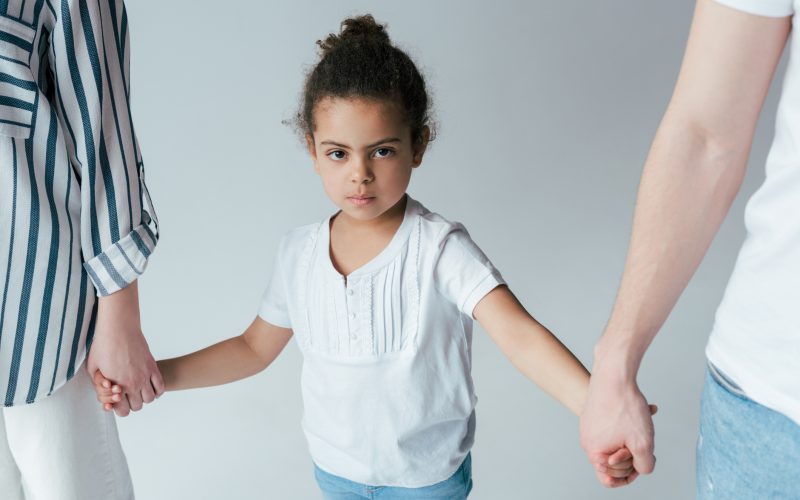Parenting techniques such as co-parenting and parallel parenting are available to parents no longer married, cohabiting, or in a romantic relationship.
Most divorced parents have established similar parenting agreements in the last two decades.
This arrangement allows one parent (the primary custodian) the majority of time with the child; the youngster would live with that parent, while the other parent would have frequent visitation time.
Traditional custody and visitation arrangements do not always serve the child’s best interests, as the court has acknowledged throughout time.
This is where co-parenting and parallel parenting come into play; without judicial interference, the parents can mainly select how to allocate their parenting rights.
Co-parenting
Co-parenting Shared or joint parenting is another term for co-parenting. Co-parenting is a type of parenting in which the child’s parents get along well.
Even if the child’s parents are separated or divorced, they seek to share equal responsibility for their upbringing, and the youngster has a strong bond with both parents.
The parents maintain a tight connection and work together to solve a problem with the child, who travels swiftly between their houses.
The parents attend school functions together, make decisions about the child together (the mechanics of ordinary, day-to-day parenting), and share notes regularly in co-parenting.
There is a place for dispute mediation rather than fighting when conflicts emerge. Co-parenting does not always imply a lack of conflict between the parents.
Rather than focusing on rivalry or squabbling. the parents aim to preserve a friendship or cordial relationship with their children.
They focus on being present and attentive to their child; they rise above the dispute to remain partners in parenting, ensuring their relationship with either parent is not disrupted.
The Benefits of Co-parenting
Stability
Divorce is often difficult for children. It gives a sense of discomfort and promotes stress. For the youngster, co-parenting creates a sense of routine and consistency.
Knowing that his parents are looking out for his best interests gives the child a sense of security.
Rather than being torn between two parents or choosing aside, the child will have a close, healthy relationship with both.
No Parentification
Parentification occurs when the kid and parent roles are reversed. When a child feels the need to care for a parent following a divorce, this is known as parentification.
In the household, the youngster learns an unacceptable level of responsibility. They are constantly attempting to mediate between his parents.
Studies have shown that children who participate in parentification are less likely to desire to be parents themselves as adults.
Co-parenting reduces the danger of parentification because the child sees that the family unit is still working at a healthy level.
Consistency
Co-parenting establishes a pattern of behavior. Both parents can nurture similar house rules, discipline, and rewards in any household.
Co-parenting establishes a rhythm and a sense of belonging for the child, regardless of where he is that week. Co-parenting aids parents in establishing boundaries and limits, teaching appropriate conduct, and providing stability.
When the parents work together as a team, the child does not expect a separate response from each parent when he asks for something.
Remain a Family
Co-parenting relieves the child of stress and reassures him that, despite their separation, the parents are still a family.
It assures the youngster that he will not have to choose where they will spend their holidays or special occasions. Both parents interact with their children as a family, perhaps even going on outings or sharing important occasions.
Improved Psychological Adjustment to Adulthood
Research demonstrates that co-parenting helps children develop stronger self-esteem and have fewer trust issues as adults. They also improve their problem-solving abilities.
Children who see their parents cooperating and co-parenting are more likely to learn how to handle difficulties independently.
Disadvantages of Co-parenting
Working co-parents may find it challenging to modify their schedules to accommodate their partners.
They share joint parental care for the child by adjusting their schedules to coincide with their partner’s, which is generally jam-packed.
Dissensions
Dissensions are unavoidable. When parents have differing viewpoints, it can be difficult for the child to cope.
Disputes over significant issues can frequently lead to the child being forced to make decisions, which can be traumatizing.
Constant travel: Co-parenting can be difficult when the parents are not close. Both parents must participate in the dropping off and picking up the child from one parent’s home to the other’s.
This constant back and forth might exhaust a toddler. Co-parenting might be difficult for a parent who has to relocate frequently or unexpectedly for employment.
They may be unable to provide the necessary stability for co-parenting. The parent cannot devote the time required to co-parent the child.
Regardless of how hard the parents try to ensure that the child spends equal time with each of them, the youngster always prefers to spend more time forming a stronger attachment with that parent.
The other parent may grow envious, resulting in a fight.
Co-parenting Work Guidelines
Do not rely on the child as a messenger while discussing difficulties or queries with the other parent. Both parents should keep a friendly relationship.
Neither parent should display anger or negative feelings toward the other parent in the child’s presence.
Essential items should be duplicated at each parent’s house so the child does not have to pack as much while moving.
The child’s visit with the other parent should be good or neutral for both parents. The youngster should have some say in how much time each parent spends with them.
This becomes increasingly vital when the youngster ages and desires to socialize with peers.
Parallel Parenting
Parallel Parenting is a term that refers to the practice of having two.
When divorced parents cannot communicate constructively, parallel parenting allows them to care for their children by disengaging from each other and having limited direct contact.
Parallel parenting is for parents unable to communicate, collaborate, or solve difficulties.
Both parents keep everything separate, assigning certain days to attend school events separately, not attending doctor’s appointments together, and only exchanging information via emails (writing).
Because switching back and forth between the homes of high-conflict parents can be harmful to a child’s psychological and emotional well-being, one parent is designated as the primary parent in parallel parenting.
In parallel parenting, there are clear, defined boundaries between parents. They do not attend child-related functions together.
Schedules are shared via calendar or in writing, and no changes to the program are made without a written agreement.
They do not attend child-related functions together, schedules are shared via calendar or in writing, and no changes to the program are made without a written agreement.
Parents can be detached from one another while being close to their children through parallel parenting.
Parallel Parenting’s Benefits
Reduces Conflict
When a couple has a high-conflict divorce, the child suffers during parent-child interactions. Parallel parenting allows the couple to have fewer encounters, which means the child is less exposed to parental conflict.
Parenting Disagreement Between Individuals
In parallel parenting, each parent follows their own set of rules or parenting styles.
If one parent is religious and the other is not parenting, it allows each parent to establish their own house rules and parenting style.
The nonreligious parent is relieved of taking the child to church or scheduling study time.
Even though the child is initially confused by the difference in parenting styles, the child will rapidly learn the differences between the two houses.
A More Tranquil Atmosphere
Parallel parenting allows children of high-conflict parents to live in a more peaceful setting by reducing both parents’ face-to-face interactions.
Stress is detrimental to a child’s happiness; nevertheless, parallel parenting can help reduce the tension in the child’s life.
Parallel parenting allows both parents to have a positive relationship with their children without relying on one another.
Both parents are involved in their children’s lives, and neither parent has greater power over their child than the other.
Both parents share the duty for their children.
Allows for Slow Recovery
Some people take many years to recover from the pain of a harsh divorce. Running into an ex might sabotage the healing process when a child is involved.
Parents can be apart while being involved in their children’s lives using parallel parenting.
The distance prevents flare-ups, allows the parent to respond proactively rather than reactively, and prevents emotional outbursts that could impede the healing process.
Parallel Parenting’s Disadvantages
Conflicting parenting styles are a fundamental disadvantage of parallel parenting.
Each parent makes decisions without consulting the other, often leaving the youngster trapped in potentially confusing ways.
For example, if one parent wants the child home by 8 p.m. while the other allows until 10 p.m., the youngster will be frustrated by the difference in parenting approaches.
Another downside is that parents may compete for time with their children and emphasize quantity more than quality when spending time with them.
The child might be used against the ex-spouse as a weapon. Negative comments about the other parent may be said to the child, which can have serious ramifications for the child-parent connection.
Suggestions for Making Parallel Parenting Effective
It’s good to make an early parenting plan to keep direct communication between the parents at a minimum.
Relying on the child to communicate information between the parents is not a good idea. Both parents should follow the parenting schedule.
A documented agreement should be in place. Parent communication diaries should describe their feelings, behaviors, and other vital information when the child is in their care.
When the parents must meet, a mediator should be present. A third party should be present if both parents must meet face-to-face to discuss essential matters such as education, religion, or medical care.
A court-appointed mediator is an excellent third party for resolving disputes.
Parenting with an ex is difficult; it requires time and thought to determine the optimal parenting style for the child.
Co-parenting and parallel parenting both necessitate some degree of cooperation and communication.
According to research, fighting between parents causes the most anguish for a child after the parent’s divorce. Thus, parallel parenting is not a bad idea.
Parallel parenting is the best option for high-conflict couples who cannot converse politely. When it comes to divorce and parenting, there are no black-and-white options.
You are the only one who can choose which parenting style will work best in your situation. You may discover that your demands vary with time, causing you to alter your parenting style.
Parents may transition from parallel parenting to co-parenting over time. Both co-parenting and parallel parenting are excellent possibilities for raising a child while divorced.








